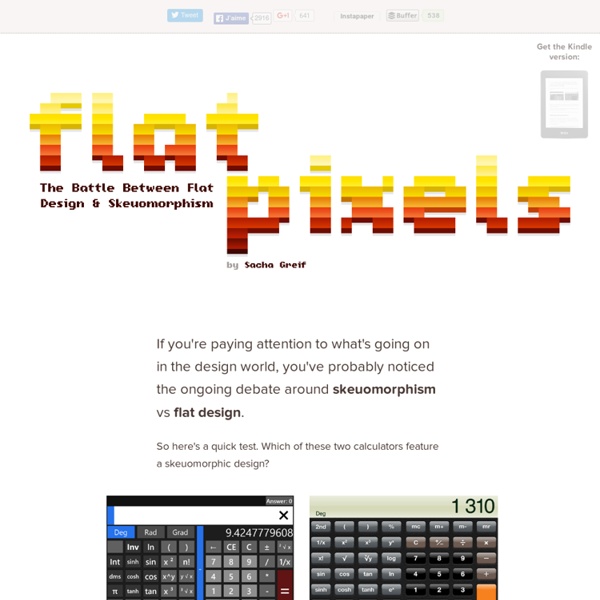Flat Pixels: The Battle Between Flat Design And Skeuomorphism

The Design Battle Behind Apple's iOS 7 | Wired Design
Jony Ive.Photo: Alex Washburn/Wired Photo: Alex Washburn/Wired Photo: Alex Washburn/Wired Photo: Alex Washburn/Wired The new iOS 7 is radically simplified, incredibly flat, colorful, and multi-layered. It is, according to Apple CEO Tim Cook, “the biggest change to iOS since iPhone.” And it may be one of the best things yet designed by Jony Ive, who announced iOS 7 in a short video at Apple’s World Wide Developer conference. Ive didn’t offer a blow-by-blow account of details; he remained seated in the audience next to Laurene Jobs. Among the many features and UI ideas, the main design points were: –A revamped icon system, based on a grid that harmonizes the many tiles of the UI –Redesigned typography –A new color palette –Distinct functional layers for apps and navigation screens –Abundant use of translucency that creates hierarchy among layers –Animations that add depth and live information –A swipe-up control center for commonly used functions iO6’s fake wood, leather, and felt are dead.
MIT's Gmail Visualization Tool: How It Works
Ever wonder how the endless emails in your inbox are all interconnected? Or your most frequent email contact? Or how your inbox has been affected over the years by the new people in your life? Last week, the Massachusetts Institute of Technology's (MIT) Media Lab announced a new tool that uses your Gmail metadata to build a visual map of the web you've created with others. The tool, called Immersion, has clearly resonated with people. And due to the influx of traffic, the site even crashed the site temporarily. The team behind Immersion is billing it as a way to dive into the history of your email life. "If you look at the big picture, Immersion is a visual representation of the webs that you have woven with other people through email conversations," Immersion co-creator Deepak Jagdish told Mashable via email. Here's how it works: Upon visiting it, the Immersion website prompts you to securely connect your Gmail address to the service. Image via MIT's Media Lab, Immersion
Rockmelt
Log in | Tumblr
See the ebb and flow of Citi Bikes in New York City
After two months on the street, New York's first bike-sharing program Citi Bike is starting to yield some interesting data about how riders are actually using the service. Citi Bike has made this kind of data surprisingly transparent — it's simple to see real-time information on where bikes are available – but the New Yorker went one step further, measuring usage at fifteen-minute intervals from June 8th through July 8th and plotting it on an interactive map. On the surface it might just look like a bunch of pulsating bubbles, but upon looking further you can see the city come alive: a herd of commuters traveling south to the Financial District, or meandering weekend journeys, or a westward trek just before the July 4th fireworks on the Hudson river.
Immersion: a people-centric view of your email life
Watch the Intricate Patterns of Global Infrastructure Emerge From Geocoded Tweets - Emily Badger
You may have seen earlier this summer a series of maps released by Twitter showing the geography of different cities as revealed by millions of tweets. Such maps of digital information are compelling for the way they also illustrate concrete infrastructure: the road networks around cities, the public parks inside of them, the clusters of commercial office buildings. If you missed your own city in that series, Northeastern University assistant professor of computer science Alan Mislove has created a global, navigable map using much of the same data. Maps of geo-tagged tweets always represent a biased sample of a biased sample. Tons of people aren't on Twitter. And of those who are, the vast majority never opt in to sharing their geographic location. "The fact that you can see roads for example," Mislove says, "took me completely by surprise." We've embedded Mislove's full map below. A similar stretch of ferries run between Holyhead in the U.K. and Dublin:
Beyond The Beep — Skype's UI Sounds
Related:
Related:


